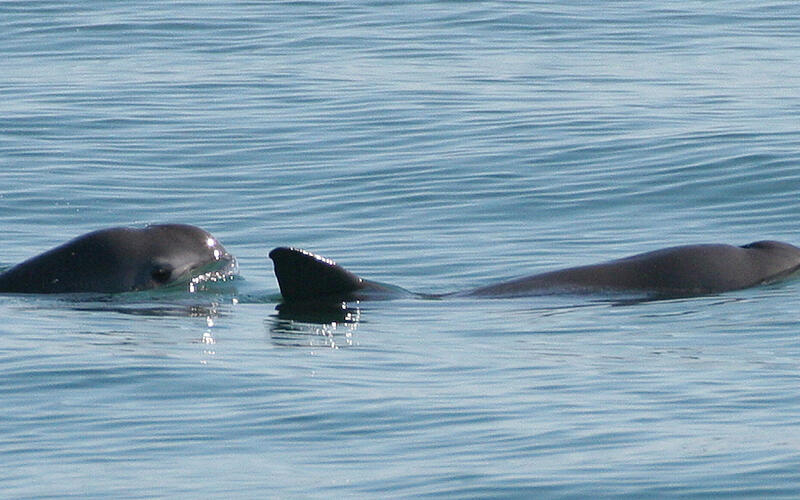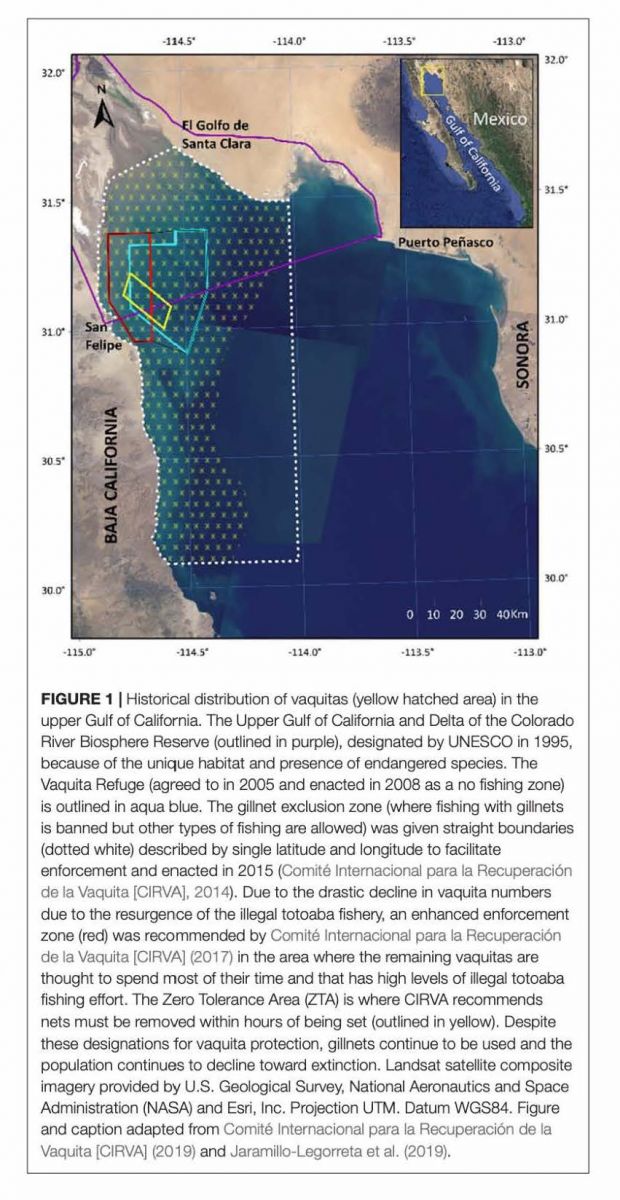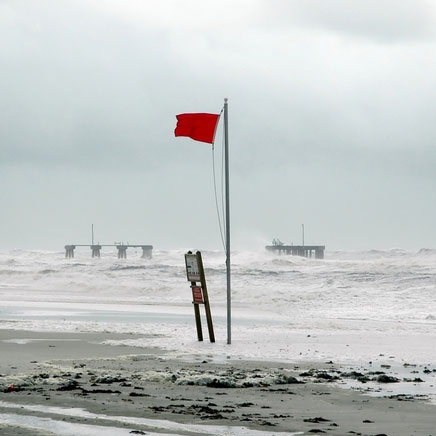Saving the ‘panda of the sea’: Aligning economic incentives with regulations to save the critically endangered vaquita

Saving the ‘panda of the sea’: Aligning economic incentives with regulations to save the critically endangered vaquita
Affectionately dubbed the “panda of the sea” for its distinctive eye markings, the vaquita is the world’s most critically endangered marine mammal. Saving the vaquita requires an integrated approach that looks beyond the immediate cause of the species’ near extinction — fishing net entanglement — to address the social, political, and economic challenges faced by coastal communities of the Upper Gulf of California.
Enrique Sanjurjo-Rivera et al. “An Economic Perspective on Policies to Save the Vaquita: Conservation Actions, Wildlife Trafficking, and the Structure of Incentives.” Frontiers in Marine Science 8 (August 2021). https://www.frontiersin.org/articles/10.3389/fmars.2021.644022/full
Miguel A. Cisneros-Mata, Juan A. Delgado, & Demetrio Rodríguez-Félix. “Viability of the vaquita, Phocoena sinus (Cetacea: Phocoenidae) population, threatened by poaching of Totoaba macdonaldi (Perciformes: Sciaenidae).” Revista de Biología Tropical 69, no. 2 (April 2021): 588-600. https://revistas.ucr.ac.cr/index.php/rbt/article/view/45475
Phillip A. Morin, et al. “Reference genome and demographic history of the most endangered marine mammal, the vaquita.” Molecular Ecology Resources 21, no. 4 (May 2021): 1,008-1,020
https://onlinelibrary.wiley.com/doi/full/10.1111/1755-0998.13284
Victoria Dunch, “Saving the vaquita one bite at a time: The missing role of the shrimp consumer in vaquita conservation.” Marine Pollution Bulletin 145 (June 2019): 583-586.
https://doi.org/10.1016/j.marpolbul.2019.06.043
Vaquitas (Phocoena sinus) are on the brink of extinction. Despite longstanding recognition of the species’ endangered status, efforts to protect vaquitas from the sole threat driving their extinction have been unsuccessful. Expanding spatial refuges for vaquitas (see Figure 1) has been ineffective due to lack of enforcement. In April 2022, around eight individuals were estimated to remain. However, a recent study led by Dr. Phillip Morin of the U.S. National Marine Fisheries Service indicated that the vaquita population is genetically healthy. Building on this work, a research team led by Dr. Cisneros-Mata of Mexico’s National Institute of Fisheries and Aquaculture analyzed demographic models. Cisneros-Mata et al. concluded that if gillnets — walls of netting that entangle and drown the small porpoises — were immediately and permanently removed from their habitat, vaquitas could recover to a sustainable population. But increasing compliance with the existing gillnet ban requires more than just strengthening enforcement; a community-based approach to fisheries management in the Upper Gulf of California (UGC) is also necessary to align economic incentives with vaquita conservation.
The smallest of marine porpoises, vaquitas have a relatively tiny habitat: about 111 square miles (less than half the size of Chicago) in the UGC. Located between the Baja California peninsula and the western coast of Mexico, the UGC is under Mexico’s jurisdiction. Over the past two decades, Mexico has deployed numerous policies and programs to protect vaquitas from gillnets. In April 2021, a multidisciplinary panel of experts who convened at the North American Association of Fisheries Economists analyzed Mexico’s conservation actions between 2007 and 2021 to evaluate their impacts on the vaquita and surrounding communities. Led by fisheries economist consultant Enrique Sanjurjo-Rivera and ecologist Dr. Sarah Mesnick, the panel developed recommendations for more effective approaches to vaquita conservation. The authors concluded that the complex and deep-rooted socioeconomic issues that have led to the vaquita’s near extinction can only be resolved by combining top-down and bottom-up policy approaches. That is, consistent regulatory enforcement must be accompanied by participatory fisheries management. Leveraging economic incentives can help win community support.
Despite the ban, fishers continue to use gillnets in the UGC for shrimp and finfish, such as totoaba. Gillnets set for totoaba pose the greatest risk to vaquitas due to the species’ similar sizes and habitat overlap. Fishing for shrimp is legal using other gear. On the contrary, catching totoaba is always illegal because it is endangered from years of overfishing. Totoaba demand stems from its popularity in Traditional Chinese Medicine, where a soup made with the fish’s swim bladder is believed to offer health benefits. Demand for totoaba bladders is so high that they have been dubbed “aquatic cocaine” — and in fact, totoaba bladder is worth more than cocaine by weight on the Asian black market. The illicit totoaba trade is so lucrative that cartels have largely taken over the UGC poaching scheme, utilizing well-established trafficking routes to export the product. Following the 2010 surge in totoaba bladder demand in China, vaquitas experienced their most precipitous decline on record: 50 percent of the population was lost in a single year.

Mexico’s efforts to save the vaquita have ranged from buying back fishing licenses and offering seed funding for new businesses, to paying local fishers to develop and test alternative gear. However, Sanjurjo-Rivera et al. concluded that these initiatives have fallen short because they did not align with economic incentives. Paying people not to fish proved ineffective because license-holders lacked the incentive to share funds with their crews. This initiative deepened economic disparities and pressured some cash-strapped fishers to poach totoaba. Purchasing fishing licenses resulted in fishers doubling net lengths under their remaining licenses. Elevating endangered species “extraction” from a minor offense to a felony also failed to deter totoaba poachers. The profitability of gillnet fishing, combined with a low likelihood of being caught and prosecuted, continues to skew economic incentives toward illegal fishing. Combined with limited financial and training support for alternative livelihoods, UGC fishers have little reason to use different gear, fish outside exclusion zones, or take jobs outside of the fishing sector.
Elimination of totoaba poaching through strict, consistent enforcement remains the top priority for vaquita conservation. But Mexico could also improve compliance with conservation regulations by creating economic incentives for local communities to abandon gillnet fishing. Fishing with other gear hasn’t caught on because fishers perceive it as less effective and profitable. To encourage an end to gillnet use, Sanjurjo-Rivera et al. recommend dedicating more government resources toward the development of new fishing technologies and incorporating fishers’ perspectives in regulatory design. Lax enforcement of licensing requirements has effectively converted the UGC into an open-access fishery, contributing to local poverty, inequality, and organized crime. Implementing a comprehensive rights-based fishery management scheme could create a sense of ownership among fishers, fostering greater regulatory compliance by aligning management measures with personal interests. To be effective, conservation actions must not only benefit the vaquita, but must also facilitate the ability of local fishers to earn a living legally and sustainably.
Another way to address the comparatively low profitability of lawful fishing is by creating a market niche for UGC shrimp caught with vaquita-safe nets. Premium pricing for vaquita-safe UGC shrimp could raise the return fishers get for their efforts. Victoria Dunch from the University of Miami Department of Biology suggests applying lessons from the example of dolphin-safe tuna; vaquita bycatch can be reduced by developing “ecolabels” with certain standards and certification criteria. Successful implementation of this program requires improving the traceability of seafood supply chains and creating awareness about vaquitas among shrimp consumers. To increase their effectiveness, public awareness campaigns could include photos or cartoon renderings of vaquitas, using their panda-like face to increase consumer empathy.
To reduce totoaba demand, Sanjurjo-Rivera et al. recommend using strategies that have helped reduce shark-finning in China — stigmatize possession of totoaba bladders, increase political accountability for failure to enforce market bans, and recruit celebrities to speak out against their consumption. While totoaba aquaculture has been suggested as a strategy to alleviate poaching intensity in the UGC, experts familiar with trafficking of endangered species specimens caution that this approach could do more harm than good. Selling farmed wildlife organs legitimizes perceived health benefits and normalizes possession, while also creating an opportunity for illicit products to be laundered and passed off as legal in commerce. Conversely, raising public awareness that there are no scientifically-backed health benefits of totoaba bladder and that their consumption is accelerating extinction of the vaquita is crucial. These efforts could be further strengthened by leveraging the significance of pandas in Chinese culture — particularly as a symbol of diplomacy — by drawing parallels with the “smiling panda” of the sea. Including this nickname in public awareness-raising campaigns may help align cultural values with conservation goals.
The vaquita is dangerously close to extinction, but it is not too late. There is still a real possibility that, with urgent action, this unique species could recover. With the support of the international community, the Mexican government can invest in the development of alternative fishing methods and livelihoods for coastal communities of the UGC, creating a structure of incentives where legal activities benefit communities and individuals more than illegal activities. If the strategies outlined above are successful, they could be applied elsewhere. For example, management lessons from the UGC may apply to other small-scale fisheries where policies to reduce bycatch and overfishing conflict with local values, cultural identities, and economic wellbeing. Furthermore, vaquitas are part of a growing trend linking organized crime, wildlife trafficking, and biodiversity decline. Tackling endangered species trafficking requires addressing the complex socio-ecological context in which these problems arise, along with other economic, political, and institutional obstacles. Marine wildlife conservation must be reframed as not just an endeavor to benefit animals, but one that strengthens coastal communities, too.




